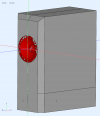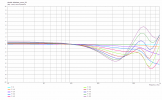Add in that I recall it also may depend on how clean the bass is…
Recall reading that our hearing can localize high order harmonic distortion.
Recall reading that our hearing can localize high order harmonic distortion.
I'd say size of the speaker, in general, would affect the crossovers used and so on. Also, positioning the speaker would change distance to all boundaries and affect perceived sound.Looks as though the best answer here is it depends on speaker location.
Perhaps the poll should be updated to be clear that there may be more than one frequency. Or may be what worst case is?
You can do rough reasoning on this subject. I'm not sure such thing is concern in a properly sized 3 way system but lets take some arbitrary two way speaker for a quick thought experiment.Recall reading that our hearing can localize high order harmonic distortion.
You can do rough reasoning on this subject. I'm not sure such thing is concern in a properly sized 3 way system but lets take some arbitrary two way speaker for a quick thought experiment.
There is cone break up on our woofer, say at 2kHz, having 10db boost on axial response and 10db dip otherwise on the listening window. Now, the kick bass comes in and makes some harmonic distortion happen in the driver since there is great excursion. Any distortion products, harmonics, that happen in the driver motor for example get now 10db boost on-axis around the 2kHz, around the crossover, and might be first hint of distortion you hear as you feed more power to the speaker if you happen to listen on axis, distortion beaming. Not sure how this would affect localizationAnyway, example of distortion emitted differently as the direct sound.
Or another quickie, subs, lets take 80Hz is not localizable as its taken some kind of standard for movies LFE, crossover there. 2nd harmonic at 160Hz, third, 240Hz, yeah, fourth 320Hz for sure. These would be rather omni for home subs. Better to scale up the cone area to suppress harmonic distortion, if localization is a concernOr use some acoustic low pass.
It's always okay to ask questions, and I'm sometimes way off base with my assessments. Your comments have encouraged me to delve a little deeper into the subject.ctrl, I kind of caught on your words of "disturbing" and "significant" effect of early reflections but cannot reason why that would be and started poking on it. Sorry about that, I could have just asked what have you experienced on the subject, and read all the "might"s and" could"s as well
 B)
B)  C)
C) 
 C)
C)
 B)
B) C)
C)
 (It's because the on-axis SPL is very low).
(It's because the on-axis SPL is very low).




Hi,@ctrl, I may have missed, but gather your sims do not include any eq, phase or timing being applied to the side firing woofers?
P.S. suggest it is a fair assumption that most commercial (active) speakers with side firing woofers, are doing some tailoring of their output?








It's the raw data of an "ideal woofer" in a cabinet (even the inner volume of the cabinet was not taken into account, since it is not relevant for the analysis).@ctrl, I may have missed, but gather your sims do not include any eq, phase or timing being applied to the side firing woofers?
As @tmuikku said, any loudspeaker designer today, commercial or DIY, will use off-axis measurements in their development and will adjust the crossover for best results using tools like VCAD.P.S. suggest it is a fair assumption that most commercial (active) speakers with side firing woofers, are doing some tailoring of their output?
Thanks for the real life data! This confirms that, in principle, the simulations provide realistic data. The cabinet dimensions and number of drivers are not comparable, but the basic radiation behavior is.In twin dual opposed. the woofer is close enough to omnipolar, to about 300Hz.


Wish that VCAD would support stepped colors and the default step size of 3dB in the sonograms, the current display is hardly interpretableIn this sense vcad sims are perfectly fine guideline. In reality there is going to be some wiggle or various reasons, that even the BEM sims don't show, like box resonances.
Hi,Screenshot of the screenshot in post#71, shows the missing "step" in radiation caused by cabinet depth when using VCAD.
I suggest you should read user manual or look context menu.Wish that VCAD would support stepped colors and the default step size of 3dB in the sonograms, the current display is hardly interpretable

I also think that name of the topic is wrong. Directivity index of symmetrical sidemounted woofer concept dives to zero dB or below quite soon below the lowest crossover so correct question would be "What is maximum frequency where DI of conventional box speaker (or cardioid at mid...high) can dive to zero dB or below?". Higher diving freq. than 100 Hz could sound obscure and can be very sensitive to distance to front wall. That is the main design flaw of Blade and LS60 concept imo. Those speakers must be located very far from front wall to avoid self evident problems due to DI=0 and strong reflections from the front wall. Low XO freq. enables using in-phase reflection at upper bass with quite short distance to front wall and below typical Schroeder frequency. DI dives to 0 dB at some frequency above the lowest octave with other than full range cardioids so location should be adjusted carefully anyway.
This speaker is 4-way with the lowest XO ~140 Hz. DI dives to 0 dB at ~110 Hz, and cardioidish range with help of symmetrical sidemounted woofers starts quite soon above the lowest XO. Responses are quite much different than Kef's design products.
View attachment 267615
View attachment 267622
Major dip or dip and hump due to 1st order front wall reflection is created in every location where side woofers are 300 mm or longer from front wall and XO > 350 Hz i.e. speaker is omni-directional due to symmetrical sidemounted woofer concept.When you say the KEF Blade would have to be very far from front wall, could you be more specific?
